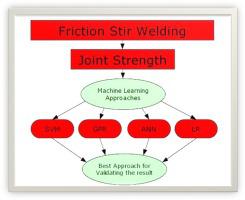Materials Today Communications ( IF 3.8 ) Pub Date : 2020-12-02 , DOI: 10.1016/j.mtcomm.2020.101933 Shubham Verma , Joy Prakash Misra , Jaspreet Singh , Usha Batra , Yogesh Kumar

|
The present study deals with the application of machine learning approaches such as Gaussian process regression (GPR), support vector machine (SVM), artificial neural network (ANN), and linear regression (LR) in analyzing and predicting the tensile behavior of friction stir welded AA7039. For this, FSW experiments are conducted at different values of rotational speed, welding speed, and tilt angle whereas the ultimate tensile strength (UTS) is considered as an output parameter. Besides this, the coefficient of correlation (CC) and root mean square error (RMSE) are considered as performance measurement parameters. It is observed that for a combination of process parameters, the ANN model is most useful for predicting the tensile behavior of FS welded AA7039 with minimum values of RMSE and maximum value of CC for test data set. Conversely, the LR model is found insignificant with maximum RMSE for test data set. In addition, electron backscattered diffraction (EBSD) is used to determined the grain size of base metal and nugget zone (NZ). The minimum grain size is obtained for higher strength specimen i.e. 4 microns.
中文翻译:

使用机器学习预测FS焊接AA7039的拉伸性能
本研究涉及高斯过程回归(GPR),支持向量机(SVM),人工神经网络(ANN)和线性回归(LR)等机器学习方法在分析和预测摩擦搅拌的拉伸行为中的应用焊接AA7039。为此,在不同的转速,焊接速度和倾斜角值下进行FSW实验,而极限抗拉强度(UTS)被视为输出参数。除此之外,相关系数(CC)和均方根误差(RMSE)被视为性能测量参数。可以看出,对于工艺参数的组合,对于测试数据集,具有RMSE最小值和CC最大值的ANN模型对于预测FS焊接AA7039的拉伸性能最为有用。反过来,LR模型对于测试数据集的最大RMSE不重要。此外,电子背散射衍射(EBSD)用于确定贱金属和熔核区(NZ)的晶粒尺寸。对于更高强度的样品,即4微米,可获得最小晶粒尺寸。



























 京公网安备 11010802027423号
京公网安备 11010802027423号